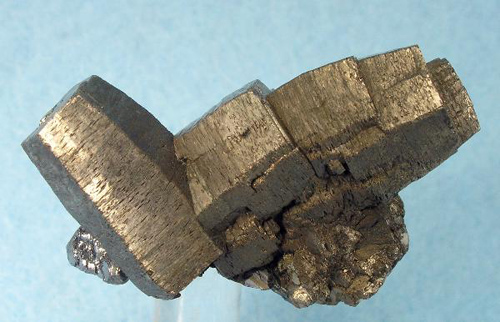The Mineral pyrrhotite

Pyrrhotite is unusual in that it maintains a variable iron content, as reflected in its odd chemical formula. The variability is formed by deficiencies of iron in its chemical structure, which is also responsible for its magnetic properties. Greater deficiency of iron is responsible for stronger attraction to magnetic fields. If the mineral lacks any iron deficiencies, it is no longer Pyrrhotite, but a rare, non-magnetic mineral called Troilite. (Troilite usually originates from meteoric sources.)
The variation of iron in Pyrrhotite's structure is also responsible for more than one crystal
symmetry type, allowing it to form in both
hexagonal and
monoclinic symmetries. Multiple crystal symmetries should technically classify Pyrrhotite as a mineral group rather than a single mineral, but a sub-classification is rarely made due to
polytypes appearing similar and perhaps even combined within individual specimens. Though most Pyrrhotite specimens are
stable, some tend to crumble in collections.
Pyrrhotite is commonly
pseudomorphed by
Pyrite, with complete
replacement of the Pyrhottite by sparkling Pyrite crystals. Pyrrhotite is named from the Greek word
pyrrhos, which means "color of fire". This is despite the fact that the usual color of Pyrrhotite is a bronze color rather than red; however its
tarnish may have hints of sparkling red.
Chemical Formula
Fe1-xS
(where x ranges from 0.0 to 0.2)
Color
Metallic yellow, bronze, dark silvery gray. Crystals may tarnish on exposed surfaces, usually darkening, and sometimes with a mild red or blue iridescence.
Crystal System
Monoclinic
Properties
Streak
Dark gray to black |
Hardness
3.5 - 4.5 |
Transparency
Opaque |
Specific Gravity
4.5 - 4.6 |
Luster
Metallic |
Cleavage
None, though exhibits basal parting |
Fracture
Uneven |
Tenacity
Brittle |
Other ID Marks
Strongly or moderately attracted to magnetic fields.
|
Crystal Habits
Pyrrhotite forms in several crystal polytypes with possible symmetry in more than one crystal group. Crystals are usually pseudohexagonal in shape, and they may be flat or wider midsections. A well-known habit is as stacked prismatic barrel-shaped crystals. Also tabular, in platy aggregates, bladed, in hexagonal rosettes, and in groups of integrown tabular hexagons and barrels. Commonly grainy or massive. Crystals are usually horizontally striated, and frequently have cracks in them.
Uses
Pyrrhotite is an ore of iron. Well crystallized Pyrrhotite specimens are important collectors minerals. The aesthetic prismatic crystal forms are especially treasured by collectors and in high demand.
Noteworthy Localities
Several localities worldwide have produced outstanding examples of Pyrrhottite in attractive crystals and aggregates. Well crystallized and lustrous platelets are well known from Dal'negorsk, Primorskiy Kray, Russia; and highly lustrous, intergrown crystals clusters have been recently coming from the Yaogangxian Mine, Hunan Province, China. Etched crystals are classics at the Herja Mine, Chiuzbaia (Kisbánya), Baia Mare, Maramureș Co., Romania; and well-formed flattened crystals and rosettes have come from Trepča, Kosovo.
In Brazil, flattened bronze Pyrrhottite crystals have come from the Morro Velho mine, Nova Lima, Minas Gerais. Thick, prismatic crystals, representing some of the best forms of this mineral, are classics at the Potosí Mine, Santa Eulalia District, Chihuahua, Mexico.
Pyrrhottite is common in many ore deposits in the U.S., but rarely in good crystals. American localities of note include Trumbull, Fairfield Co., Connecticut; and Franklin, Ogdensburg, and Sparta, Sussex Co., New Jersey. In Canada, thick, often stacked crystals have come from the Bluebell Mine, Riondel, British Columbia; and microcrystals are known from Mont Saint-Hilaire, Québec.
Distingushing Similar Minerals
Pentlandite, Pyrite, and Chalcopyrite - Lack any attraction to magnets.
Hematite and Magnetite - Different color and crystal habits.